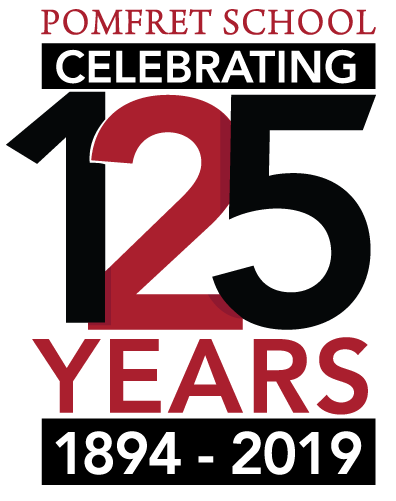Our history is an unbroken line.
We were innovators from the outset. Outliers since the very beginning. Never satisfied. Never finished. It hasn’t always been easy. The path hasn’t always been clear. But we’ve always known who we are. Our history is an unbroken line, connecting us, reminding us, that each setback is an opportunity, each challenge, an invitation: to see things differently. Pomfret is hard to describe, but easy to feel. And while some may see a school, we see an attitude — a great big way of thinking and living. Because schools don’t change the world, people do.

The Wabbaquasset Purchase
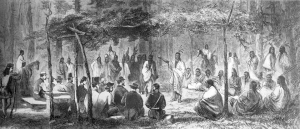
For thousands of years, the vast stretch of lushly wooded, rolling hills we now call Pomfret was home to two Native American tribes, the Nipmucks and the Narragansetts, who claimed opposite sides of the Quinebaug River. They called the valley Mashamoquet, or “at the great fishing place.” In 1684, the Sachem Owaneco gave Major James Fitch a title to the area. Two years later, Fitch sold 15,000 acres, encompassing the entirety of modern day Pomfret School, to twelve settlers for thirty pounds.
The Talented Mr. Peck
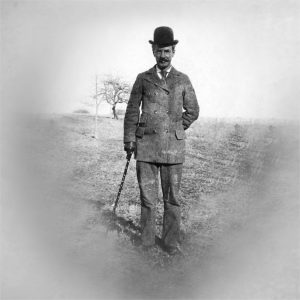
For 23 years, William E. Peck was a member of the faculty at St. Mark’s in Southborough, MA. By the time his more progressive tendencies came into conflict with the more traditional views of that school, he had risen all the way to the role of headmaster. In 1893, he left St. Mark’s to found a school of his own.
The Founding
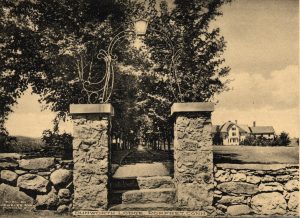
Peck’s personal reputation and charisma, as well as his ability to engender confidence, contributed to the success of the new undertaking from the very start. With his wife, Harriet, he purchased the Charles Grosvenor Inn, and on October 3, 1894, Pomfret School was born. During those early years, the Pecks lived in one of the cottages attached to the inn. A single building (the first “main house”) housed the dormitory, classrooms, and dining hall, and a nearby stable served as the first gymnasium.
William “Bull” Olmsted
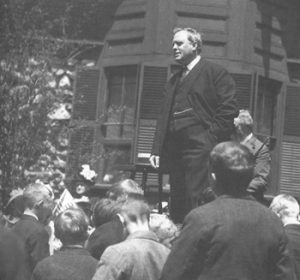
William “Bull” Olmsted served as Pomfret’s headmaster from 1897 until his death in 1929, making him the longest serving headmaster in Pomfret history. During his 32 years, he presided over the acquisition and creation of no fewer than a dozen landmark buildings, as well as hundreds of acres of land.
The End of the Beginning
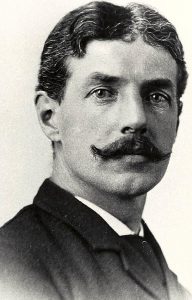
Tragically, during the winter of that year, an epidemic of bronchitis and pneumonia struck the school. Peck caught a particularly virulent strain of the disease, possibly from a sick young student who he had carried in his arms to the infirmary. He died on January 7, 1897. His death marked the end of the first, short era in Pomfret’s history.
A Period of Growth
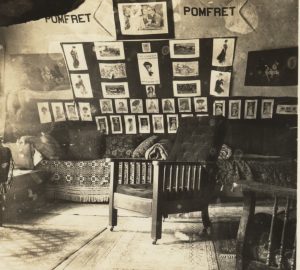
In 1905, the school hired Ernest Flagg, architect of the US Naval Academy, to draft a master plan. Over the next 10 years, Flagg would go on to design and build most of the campus core, including the School Building, the Bricks, Pyne Infirmary, Clark Memorial Chapel, and Lewis Gymnasium.
Athletic Prowess
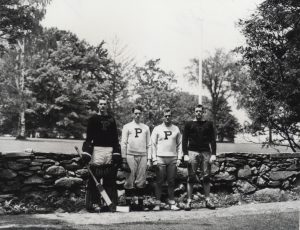
In those interceding decades, Pomfret grew not only in terms of bricks and mortar, but also in terms of enrollment and endowment. It was also a time of great athletic prowess with successful football, baseball, and ice hockey teams. Mr. Olmsted was on the field every day, and demanded the same rigorous approach to athletics that he did to academics.
Black Thursday
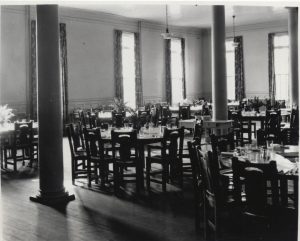
On October 24, 1929, a date that would come to be known as “Black Thursday,” the stock market crashed, creating a decade-long depression that affected most of Pomfret’s families. Later that year, Mr. Olmsted died and was buried in the crypt beneath Clark Memorial Chapel. At the time of his death, he and the school had attained such stature that his obituary was published in Time magazine.
The Great Depression
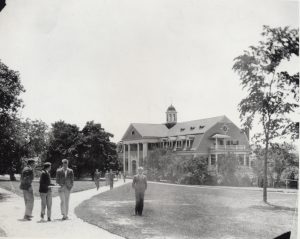
Halleck Lefferts was the third headmaster of Pomfret School. Educated at Yale, he came from the Thacher School in Ojai, California, just as Pomfret was beginning to feel the full impact of the Depression. Despite the financial troubles of the 1930s, the school continued to move forward. It was during this difficult time that biology, chemistry, and drawing were added to the curriculum; basketball and crew were added to the athletic program; and the faculty advisor-advisee system, which continues to this day, was introduced.
World War II
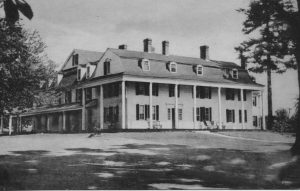
With the war looming, Lefferts resigned in June of 1942 to fight with the Army, and was replaced by Dexter Strong, who had also taught at Thacher. With Strong at the helm, the school purchased the Ben Grosvenor Inn, adding 289 acres to the campus, including a magnificent well, which remains the source of the school’s water to this day.
Soaring Enrollment
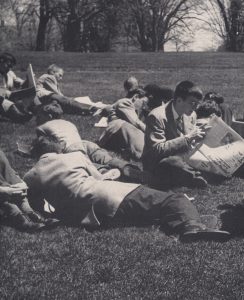
Due in large part to the creation of a regional scholarship program, enrollment soared during this period of time. In the fall of 1948, the school opened with 151 students, the largest enrollment in its history. They came from 11 states, the District of Columbia, 1 territory, and 4 foreign countries. Under the guidance of Lefferts and Strong, Pomfret had successfully weathered two of the most difficult periods of the twentieth century, the Great Depression and World War II.
The Face of Change
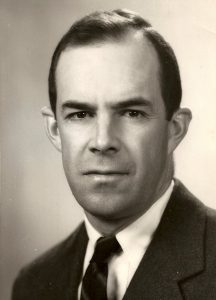
In the fall of 1951, David Twichell took the reins as Pomfret’s newest headmaster, and continued to guide the school — often through uncharted territory — for the next decade. Writing in the New York Herald Tribune in 1956, Al Laney penned a glowing review of Pomfret. Of the transitional, innovative character of Mr. Twichell’s tenure, he wrote: “Pomfret is surely unique in its headmaster, for there is hardly another such as David Cushman Twichell, who has quite unusual ideas and has done quite unusual things in his five–or six–year headmastership.”
More Flexible, Rather Than Less
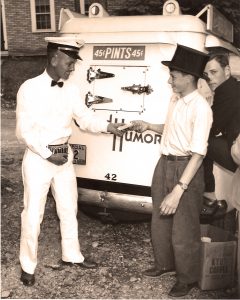
Another product of Thacher School, Mr. Twichell was an idealist in every sense of the word. He believed in his students, trusted his students, and felt that the School would be better if it were more flexible, rather than less flexible. Under his leadership, two new buildings opened: the current Main House in 1956 and the Monell Science Building in 1958. By the time he resigned in April of 1961, Twichell had transformed Pomfret into one of the most progressive boarding schools in the country.
First African American
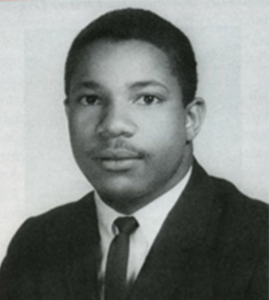
In the fall of 1961, just as the Vietnam War was heating up, Joseph Milnor became Pomfret’s sixth headmaster. Three years later, in 1964, one of the most significant events in Pomfret history would occur when John Irick, a charismatic high school student from Orangeburg, South Carolina, arrived at Pomfret for his senior year. He would go on to become the first African-American to graduate from Pomfret.
Going Coed
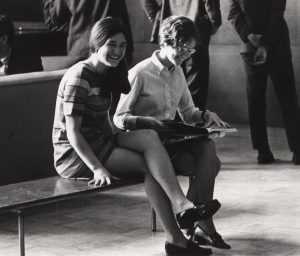
Four years later, in February of 1968, The Pontefract bannered the news that “to the joy of most, and the unhappiness of a few,” the Board of Directors had voted to admit female day students beginning the following fall. In the spring of 1973, Milnor retired from Pomfret School, leaving an indelible mark on the social fabric and political consciousness of the School.
Cutting Costs
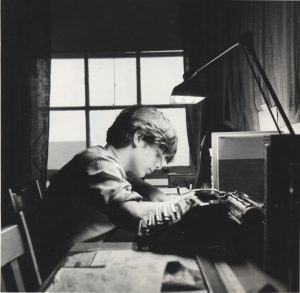
As the 1970s wore on, financial trouble returned to the Hilltop. It would fall to 34-year-old Kenneth Deitch, an assistant professor of economics from Harvard, to guide the school through its darkest days. Deitch quickly set to work, raising money and cutting costs wherever he could, including a freeze on faculty salaries. It made him the enemy of many, but probably saved the school. After three tumultuous but critically important years, Deitch left Pomfret in 1976.
Promise to Posterity

Almost immediately, the School landed on the Reverend Burton A. MacLean as its next headmaster. Over the next several years, MacLean offered a steady hand as the school slowly but surely turned itself around. In 1977, the key to the school’s financial recovery finally arrived. Called the Promise to Posterity, the $2.5 million fundraising campaign aimed to improve the physical plant, erase the School’s debts, and bolster the endowment.
The Spirit of Pomfret
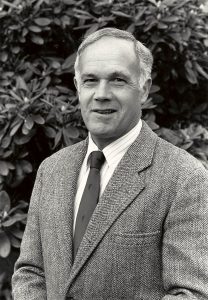
Pomfret is known for its strong sense of community, and no one deserves more credit for cultivating that sense of community than Gerrit Keator and his wife, Marnie, who arrived on the Hilltop in 1979. “Both Gerrit and I felt that a boarding school should have a warm, happy, and loving atmosphere,” Mrs. Keator said. “Therefore, I felt that my role was to be primarily an extension of my role in my own family, i.e., Chairman of the Tender Loving Care Department.”
Good Times
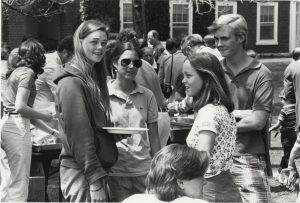
Under the Keator family’s charismatic leadership, enrollment continued to rise. In 1980, the School opened its doors with 297 students (232 borders and 65 day students), the most ever. When questioned, most students felt the school had improved dramatically. In general, there was better communication and more friendship between students and faculty, even as the level of academic rigor continued to rise.
How Lucky We Are To Be Here
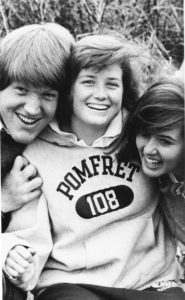
The mid-1980s also marked the introduction of two important changes to campus life. First, Keator made chapel mandatory, restoring a sense of spiritual heritage to the School. Second, he began offering teachers the funds to further their education, going so far as to offer a full-year paid sabbatical to veteran teachers. By the time Keator entered his final year as headmaster, morale was at an all-time high. “Lately I’ve noticed something about our school and everyone here,” said senior Cara Landi in 1989. “A spirit seems to be surging throughout our campus. Think about how lucky we are to be here.”
Girl Power
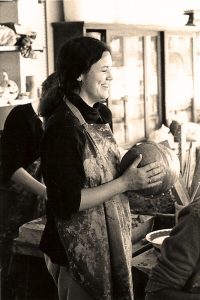
Not long after his arrival in 1989, Patrick Bassett quickly appointed the school’s first Dean of Women “to be an instigator for raising the consciousness of women’s issues.” Around the same time, he authorized the formation of a chapter of the Council for Women in Independent Schools, with the expressed intent of furthering the development of the females who studied, lived, and worked at Pomfret.
Dare to Do Things Never Tried
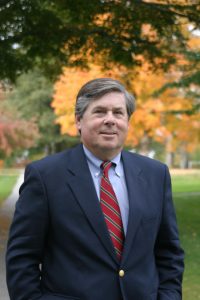
In the winter of 1992, Bradford Hastings ’68 was appointed Pomfret’s eleventh headmaster. Perhaps no headmaster since Olmsted has so fully transformed the Hilltop. A graduate of the Class of 1968, he had previously served on the faculty as a history teacher, director of athletics, and assistant director of admissions. “I want the school to increase its confidence in itself,” he said. “We should dare to do things it never tried… not just go along.”
Breaking New Ground
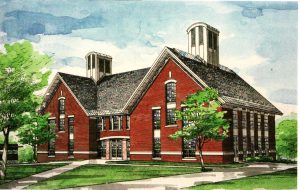
During his nearly two-decade run, Hastings oversaw the construction of a myriad of buildings, including Centennial Academic and Arts Center, Corzine Athletic Center, Olmsted Student Union, Blodgett Boathouse, Lasell Alumni House, Jahn Rink, Blodgett Tennis Center, and Olmsted Observatory. Another major improvement was the establishment of a new central power plant, which greatly reduced the School’s carbon emissions, while saving thousands of dollars in annual fuel costs. The campus and the community would never be the same.
Wisely, Differently, and Well
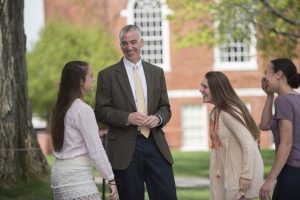
In 2011, J. Timothy Richards, a graduate of Phillips Andover and a long-time faculty member at St. George’s School, took the reins as Pomfret’s twelfth headmaster. Richards’ arrival has heralded a new approach to teaching and learning at Pomfret. “If the next generation is to flourish in a changing world,” he says, “we must prepare them wisely, differently, and well.”
The Pomfret Purpose
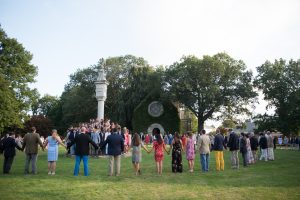
In 2013, the School launched its vision for the future: The Pomfret Purpose. Among the four goals outlined in the strategic plan, the school has set out to become a leader in learning, and to create a truly distinctive boarding school experience.
An Incubator for Emerging Ideas
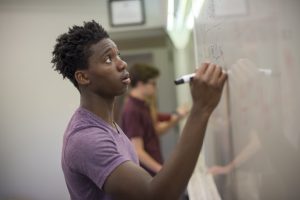
Established in 2014, the Grauer Family Institute for Excellence and Innovation is a place where thinking differently is celebrated, and new ideas are nurtured. Through progressive program design, professional development, technological advancement, and strategic partnerships, the institute is both a mechanism for mission-alignment and a catalyst for future growth.
A Tradition of Innovation
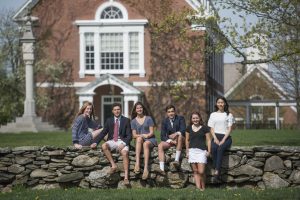
Seven years into his tenure, Richards acknowledges that change is hard, but embraces the idea that education must continue to evolve to meet the needs of a new age. Yet, while change beckons, the school remains grounded in tradition. It honors the past, but is not beholden to it. Together, these twin forces of tradition and innovation are the cornerstones of the next era in Pomfret’s history.
